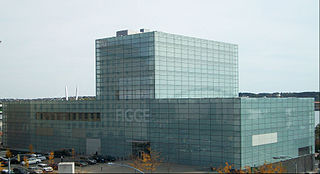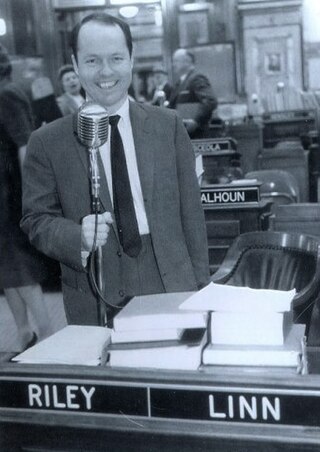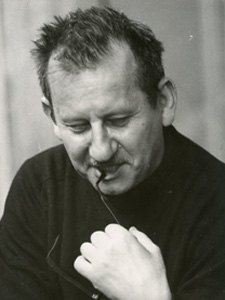
Cedar Rapids is a city in and the county seat of Linn County, Iowa, United States. The city lies on both banks of the Cedar River, 20 miles (32 km) north of Iowa City and 128 miles (206 km) northeast of Des Moines, the state's capital. The population was 137,710 at the 2020 census, making it the second-most populous city in Iowa. The population of the three-county Cedar Rapids metropolitan area, which includes the nearby cities of Marion and Hiawatha, was 276,520 in 2020. Cedar Rapids is the economic hub of Eastern Iowa, located at the core of the Interstate 380 corridor. The Cedar Rapids metropolitan area is also part of a combined statistical area with the Iowa City metropolitan area.

Grant DeVolson Wood was an American artist and representative of Regionalism, best known for his paintings depicting the rural American Midwest. He is particularly well known for American Gothic (1930), which has become an iconic example of early 20th-century American art.
The Iowa Biennial Exhibition and Archive (TIBEA) began in 2004 as an international survey of contemporary miniature printmaking with its initial exhibition held at the University of Iowa in Iowa City, Iowa. Works juried for the exhibition travel for exhibitions within the U.S. as well as internationally, with exhibitions in Cedar Rapids, Iowa and Riga, Latvia, to date.

The Figge Art Museum is located on the north bank of the Mississippi River in Davenport, Iowa. The Figge, as it is commonly known, has an encyclopedic collection and serves as the major art museum for the eastern Iowa and western Illinois region. The Figge works closely with several regional universities and colleges as an art resource and collections hub for a number of higher education programs.

The Stone City Art Colony was an art colony founded by Edward Rowan, Adrian Dornbush, and Grant Wood. The colony gathered on the John A. Green Estate in Stone City, Iowa during the summers of 1932 and 1933.
Washington High School is a public high school in Cedar Rapids, in the U.S. state of Iowa. Built in 1956, it is named in honor of the oldest high school in Cedar Rapids.

Marvin Dorwart Cone was an American painter in the regionalist style.
Conger Metcalf (1914–1998) was an American painter.

The National Czech & Slovak Museum & Library (NCSML) is a museum and library of Czech and Slovak history and culture located in Cedar Rapids, Iowa, in the United States. Established in 1974, the museum and library moved to its present site in 1983. The museum and library was severely affected by the Iowa flood of 2008. In 2012, rebuilding and expansion efforts were completed and the NCSML reopened.
The University of Iowa Stanley Museum of Art is a visual arts institution that is part of the University of Iowa in Iowa City, Iowa, United States. It is accredited by the American Alliance of Museums.

Thomas Chimes (1921–2009) was a painter and artist from Philadelphia. His work is in important public collections, including those of the Philadelphia Museum of Art, Museum of Contemporary Art, Los Angeles, the Museum of Modern Art in New York, the National Gallery of Art in Washington, D.C., The Phillips Collection in Washington, D.C., the Corcoran Gallery in Washington, D.C., the Ringling Museum of Art in Sarasota, FL, the Pennsylvania Academy of Fine Arts, the Wadsworth Atheneum in Hartford, Connecticut, and the Yale University Art Gallery in New Haven, Connecticut, among others.
The Grant Wood Cultural District is a historic district in downtown Cedar Rapids, Iowa that was certified in 2010 by the Iowa State Historical Society.

The University of Iowa School of Art and Art History is a top 10 public art school in the US. The school is part of the University of Iowa located in Iowa City, IA which awards undergraduate and graduate degrees in art and art history. The graduate program offers Masters of Arts in art and art history, Master of Fine Arts in art, and Doctor of Philosophy in art history. One of the largest departments in the College of Liberal Arts and Sciences, the school has approximately 650 undergraduate majors, 100 graduate students and 40 faculty and is consistently ranked as one of the top ten public art schools in the US. Faculty and students have included: Grant Wood, Mauricio Lasansky, David Hockney, Elizabeth Catlett, H. W. Janson, Philip Guston, Charles Ray, and Ana Mendieta.

Tom Riley was an American lawyer from Cedar Rapids, Iowa who served two terms in the Iowa House of Representatives and four in the Iowa Senate.

Theatre Cedar Rapids (TCR) is a community theatre in Cedar Rapids, Iowa. The theatre performs several stage shows every year, and offers acting classes. Each year TCR is seen by more than 50,000 patrons, who view the work of over 35,000 volunteer hours.

Bertha Evelyn Jaques was an American etcher and cyanotype photographer. Jaques helped found the Chicago Society of Etchers, an organization that would become internationally significant for promoting etching as a popular printmaking technique. She is best known for her hand-colored botanical prints and scenes from her foreign and domestic travels.

Mauricio Leib Lasansky was an Argentine artist and educator known both for his advanced techniques in intaglio printmaking and for a series of 33 pencil drawings from the 1960s titled "The Nazi Drawings." Lasansky, who migrated to and became a citizen of the United States, established the school of printmaking at the University of Iowa, which offered the first Master of Fine Arts program in the field in the United States. Sotheby's identifies him as one of the fathers of modern printmaking.

Diego Lasansky is an American artist whose focus is on printmaking, painting, and drawing. He lives in Iowa City, Iowa.
Malcolm Haynie Myers was an American painter, printmaker and professor known primarily for his Intaglio-style engravings. His work is included in numerous museum collections.

Jay G. Sigmund (1885–1937) was an American regionalist author, naturalist, and executive from Waubeek, Iowa. He was a close friend of the painter Grant Wood, author Paul Engle, and had ties to many regionalist intellectuals of his time. He published 10 books of poetry and short stories during his life.

















